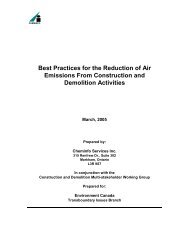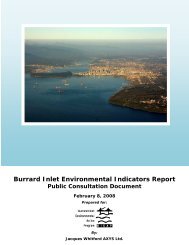Dredge Management Guidelines - the BIEAP and FREMP Website
Dredge Management Guidelines - the BIEAP and FREMP Website
Dredge Management Guidelines - the BIEAP and FREMP Website
You also want an ePaper? Increase the reach of your titles
YUMPU automatically turns print PDFs into web optimized ePapers that Google loves.
Appendix 7<br />
Appendix 7<br />
Source: PWGSC<br />
Fraser River Hydraulic Study Requirements<br />
This section outlines requirements for conducting hydraulic studies for <strong>the</strong> purposes of assessing<br />
Dredging Applications. These Terms of Reference are intended to establish consistent modelling<br />
methodologies <strong>and</strong> practices when using hydraulic models to assess impacts of dredging proposals.<br />
This should assist with expediting <strong>the</strong> review process of <strong>the</strong> study <strong>and</strong> assessment of <strong>the</strong> dredging<br />
license application.<br />
It is suggested that proponents or <strong>the</strong>ir consultants call Public Works & Government Services Canada<br />
(PWGSC) before initiating hydraulic studies to discuss details of <strong>the</strong> study methodology. This would<br />
ensure that <strong>the</strong> information requirements are established for <strong>the</strong> technical review of specific dredging<br />
proposals. PWGSC is <strong>the</strong> technical reviewer (for <strong>FREMP</strong> Lead Agencies) of dredging license applications.<br />
The following outlines details of hydraulic study requirements:<br />
Study Methodology<br />
The study must include an assessment of impacts to <strong>the</strong> local <strong>and</strong> downstream Fraser River hydraulic<br />
characteristics that may occur from conducting <strong>the</strong> dredging.<br />
Impacts to <strong>the</strong> following hydraulic characteristics to be considered:<br />
■ Local water levels<br />
■ Local flow velocities<br />
■ S<strong>and</strong>ation, Deposition/Accretion Patterns (local <strong>and</strong> downstream)<br />
■ Shoreline/Foreshore Erosion (local <strong>and</strong> downstream)<br />
■ Undermining of existing local marine structures<br />
Model Used<br />
Consultants are not limited to any specific model, but <strong>the</strong> model must be capable of providing water<br />
surface elevations, velocities, <strong>and</strong> erosion / accretion information at sufficient scale (or grid size) to<br />
quantitatively assess <strong>the</strong> impacts of <strong>the</strong> dredging using varying flow conditions.<br />
Calibration<br />
Hydraulic models must be calibrated using historic prototype site information from existing records<br />
(unless consultants are obtaining new field data for calibration purposes). Available velocity <strong>and</strong><br />
hydrographic survey records can be obtained from PWGSC. The model must show similarity of<br />
hydraulic characteristics of pre <strong>and</strong> post freshet conditions to prototype records to establish reliability.<br />
Model Extents<br />
Model area to be sufficient for assessing local <strong>and</strong> downstream impacts. Upstream area to be sufficient<br />
for ensuring model stability of flow.<br />
Surveys<br />
Hydraulic model must use current hydrographic survey data for baseline condition (e.g. Taken since<br />
previous freshet).<br />
55 Appendix 7
















